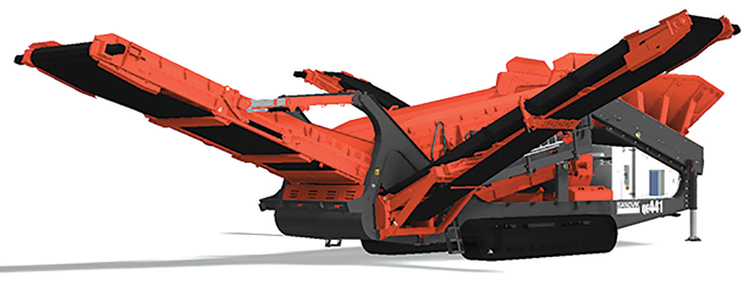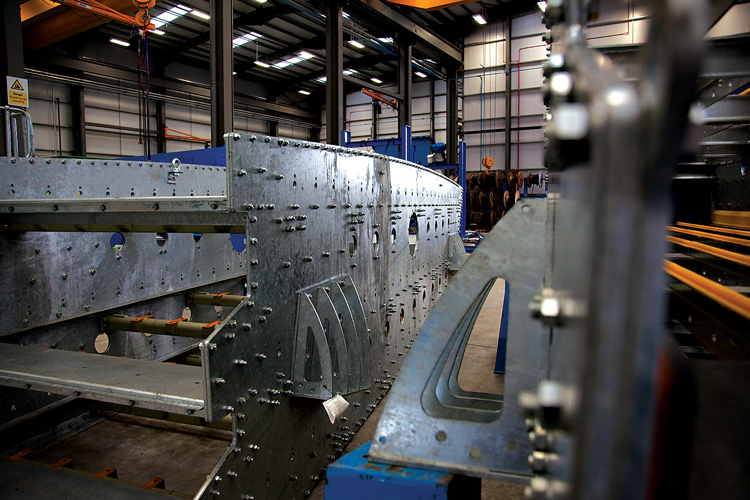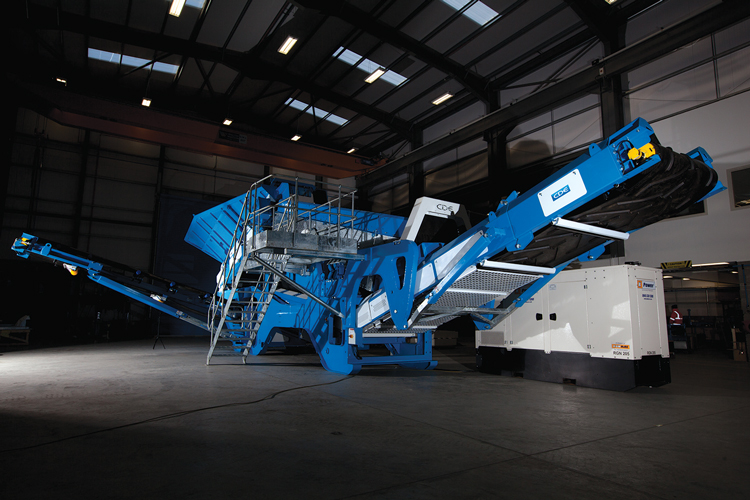
Screening machine suppliers offer new designs and expanded product lines to meet customers’ evolving needs
It’s not unusual for equipment design concepts and processing techniques to cross the imaginary border between aggregate and hard rock mineral extraction. Particularly in the case of screening machines and media, useful advances in throughput, efficiency and separation accuracy have often worked their way from one sector to the other. For example, bringing the best features of machines and components used in high-production, screen-dense aggregate plants to the hard rock industry and the ruggedness and reliability of mining-class screen machines to construction-materials producers.
The brand names of the major screen-equipment suppliers are familiar to plant operators in all sectors of the extractive industries and, as is the case in most mine-equipment sectors, suppliers occasionally fade away while most endure and others expand; some do both: A case in point is Weir Minerals North America, which recently reported that its wire screen media product line is celebrating 50 years of production in 2015 (See Durex Screen Media Reaches 50-year Milestone, p. 91, E&MJ, July 2015), while just a few months earlier parent company Weir Group announced that it had acquired Trio Engineered Products, a Chinese-American manufacturer of crushing and separation equipment for the mining and aggregates markets, for a transaction cost of $220 million (£138 million). Trio is based in Shanghai, China, where it has two manufacturing plants and primarily serves the mining industry. The company also has facilities in the United States, where its main customers are North American aggregate producers.
Other well-known suppliers have tweaked their product families to meet the changing requirements and resources of an evolving and financially stressed industry. Metso, for example, has established two new screening product ranges—Premier and Compact—which are grouped by design features and capabilities to serve customers’ unique needs.
The Premier screen range includes the CVB incline, circular-motion screen; the ES horizontal, elliptical-motion screen; and the TS multislope, variable-motion screen—all of which Metso regards as flagship vibrating products. Premier Screens are fully configurable, able to incorporate any type of screening media for maximum operational flexibility while achieving safe and simple maintenance. These screens, according to the company, appeal to customers that rank operational availability and application flexibility as the primary concern to achieve low opex in high-cost markets.
The Compact screen range includes machines that have typically been included in the company’s mobile crushing and screening plants, but are now available for single unit sales and use in stationary plants. These screens, including the CVB-M inclined screen with circular motion and the FS horizontal screen with elliptical motion, have a long history of utilization on Lokotrack mobile plants and Nordberg NW Series portable plants. In addition to the CVB-M and the FS, the company’s DF linear-motion banana screen will be offered for primary screening applications.
Metso said the Compact screen line includes carefully selected features in standard configurations. The predominant design characteristic that allows the Compact screens to be economical in terms of both size and price is their ability to accommodate side-tension screening media (wire or synthetic). These screens serve operations that need to minimize capital investment and get quickly into operation to generate revenue.
Sandvik has refreshed its flagship QE440 scalper screen with the introduction of the QE441, the latest addition to its Premium range of scalping screens. Key refinements from the previous model include improvements to the screen box, screen drive and screen media, all aimed at increasing uptime, performance and versatility. Other improvements include upgrades to the apron plate feeder, a wear-resistant hopper and radio remote controls, all of which are fitted as standard.
The new model now includes Sandvik’s control system and user interface with sequential start, and two-speed tracking to help reduce travel time between jobsites. The QE441 offers increased plant durability and operator comfort, without sacrificing on performance, according to Sandvik.

The company said the QE441 can accept the most robust infeed material and is now better suited to large mining and other applications. It can also work as a stand-alone unit feeding a primary crusher.
Principal features include:
- Next-generation 1-Series scalper.
- Total scalping area of 18 x 6 ft / 16.5 x 6 ft (5.5 x 1.75 m / 5 x 1.75 m) allowing for high rates of production.
- Capable of being fed by large crushers.
- Heavy duty crusher-type chassis.
- Designed to provide fuel economy and low operating costs.
- Track-equipped for on-site mobility.
- High stockpiling capability through integrated hydraulic conveyors.
- Easily transportable.
Terex Minerals Processing Systems introduced the MHS8203 horizontal screen module—its largest modular screening unit to date—increasing the screening capacity and application capabilities of its existing modular product range. The MHS8203 features the new Terex Cedarapids LJ-TSV 8 x 20-ft (1,438 x 6,096-mm) screen with El-Jay oval stroke action. The module’s blending gate system and rolling chute mechanism permit exceptional product control, according to the company.
Other key features include an extra-heavy-duty I-beam frame, rigid diagonal truss construction, and a galvanized steel structure including walkways, stairs and guard rails. The module structure and all of its components are CE/ISO compliant. Designed with logistics in mind, the entire MHS8203 module is easy to transport in shipping containers.
Terex’s modular product line consists of several pre-designed static and semistatic crushing and screening “plug and play” modules. Setup time and ease of operation is aided by the simplicity of the modular product range. Modules are designed to fit and work together interchangeably. All Terex MPS modules bolt together on-site and require minimal on-site wiring.
It’s been a busy year for Irish equipment manufacturer CDE Global, which announced in January the introduction of a number of new screens in its ProGrade range. According to CDE, the new screen design system provides a stronger but lighter screen that requires less power. This results from the design of the side walls on the screens, the company said, noting that the new bolted screens also have zero welds and are galvanized as standard.
An additional feature of the new ProGrade screens is the patent-pending U-Span crossmembers. The new crossmember design is modular across the ProGrade range and also has zero welds. As well as offering enhanced geometric consistency, the new design facilitates increased space between screen decks, allowing for quick and easy access to replace screen media.
Product Development Manager Kevin Vallelly said, “The first stage of the new ProGrade product launch sees the introduction of our new patented technology on a number of screens and dewatering screens. The developments will also be incorporated on the new EvoWash 100 range of sand washing plants and across the M2500, M3500 and M4500 portable washing plants and the R2500 primary screening unit.”
The new screen design system is now available on the ProGrade P2-75 (two-deck, 5 x 1.5-m screen), P3-75 (three-deck, 5 x 1.5-m screen) and P2-108 (two-deck, 6 x 1.8-m screen). The new design will also be offered on the ProGrade P3-108 (three-deck, 6 x 1.8-m screen).
 Bolted construction, redesigned crossmembers, and other design features boost reliability and serviceability for CDE Global’s ProGrade screen line.
Bolted construction, redesigned crossmembers, and other design features boost reliability and serviceability for CDE Global’s ProGrade screen line.In July, CDE Global launched the R-Series range of primary screens, which includes two new machines. The R1500 has a maximum feed capacity of 200 mt/h while the larger R2500 machine offers a maximum feed capacity of 500 mt/h. Both machines are suitable for use in the pre-screening of a wide range of materials, according to the company.
The R-Series combines a feed hopper, screen and conveyors in a variety of different configurations. The feed hopper on the R1500 has a maximum capacity of 7 mt when fitted with the optional extendable hopper sides while the hopper capacity on the R2500 unit rises to 20 mt. Both machines can be provided with either a belt feed or apron feed. The hopper has been designed to allow for feed to be delivered to the R-Series from three sides to allow maximum flexibility to cope with specific site conditions.
The R-Series introduction includes two new galvanized screens, both of which include a new patented side wall technology, which, according to the company, eliminates welds and results in a stronger, lighter screen that produces the same acceleration as traditional screens while using less power. The R1500 includes the Infinity P1-36R screen, which measures 2.4 x 1.5 m (8 x 5 ft) while the R2500 integrates the Infinity P2-75R screen measuring 5 x 1.5 m (16 x 5 ft). “The basis for the Infinity screen design was to screen better, last longer and cost less to run,” explained Kevin Vallelly. “The only assumptions we made from a design perspective were that the screen needed to be rectangular and have one, two or three screen decks. We are able to screen better because of design features like the Rosta suspension mounts, which ensure maximum transfer of energy to the material. We eliminated welds from the side walls and the screens are galvanized as standard to deliver on the promise to last longer. It’s our patented design of the side walls that allow us to ensure the screen is strengthened where it needs to be without including unnecessary weight. This allows us to produce a screen that requires less power to run.”
According to CDE, the cartridge design of the screen decks maximizes service life as it increases the durability of otherwise welded joints. The Infinity range included development of cast U-Span cross members that are weld-free and claimed to significantly reduce floor flex—reducing stress and extending the life of the machine. The company also noted that additional weight was removed from the screen due to the design of the screen shaft, which reduces the mass of the shaft assembly while still generating the same force as a solid shaft. Extensive use of replaceable wear liners at every feed and impact point maximizes machine life and includes such features as a magnetic polyurethane cover on the screen shaft, tapered rubber chutes at the screen discharge point and easy-to-replace steel wear plates in the R-Series feed hopper. The R-Series uses bearings with a unique double seal arrangement that prevents contamination during operation of the screen by reducing the risk of material and water ingress.
Site safety was considered on the R-Series, including higher side walls to prevent rocks from bouncing off the top deck of the screen. The two machines in the R-Series also include 800-mm-wide (32-in.) galvanized walkways to ensure site operators have quick, easy, and safe access for essential machine inspection and maintenance.
Stockpiling and delivery of material to downstream processing phases is facilitated with the inclusion of 9-m (30-ft) feed and stockpile conveyors in a variety of configurations. The 9-m (30-ft) stockpile conveyor for oversize material allows for a stockpile capacity of 150 m3 (196 yd3). The R-Series includes a collection conveyor underneath the integrated Infinity screen, which delivers material to an additional stockpile conveyor, or directly to the feed boot of the company’s M2500 or M4500 modular washing plants.
 An R2500 primary screen awaiting shipment at the CDE factory.
An R2500 primary screen awaiting shipment at the CDE factory.The new Terex Finlay 873 is designed to work downstream from a primary crusher or on its own as a frontline screening machine. The unit’s forward-facing, inclined, modular-configuration screenbox has 3.66- x 1.52-m (12 x 5 ft) top and bottom decks, providing a total screening area of 14.4 m2 (155 ft2). Depending on the working application of the machine, hydraulic adjustment can be used to vary the angle of the screen box between 13°–19°. The top deck of the screenbox can be fitted with a variety of screening media including tines, bofor bars, punched plate and mesh. The bottom deck can be fitted with mesh or cascade fingers.
The hopper has 7 m3 (9.16 yd3) capacity as standard with a drop rear door for use in conjunction with a mobile crusher.
The machine is equipped with three hydraulically folding discharge conveyors allowing for maximum stockpiling capacity and associated benefits of rapid setup and tear down times.
Additional features include galvanized access ladders and catwalks fitted as standard to both sides of the screen box. Hydraulic raising of the screenbox discharge end provides additional clearance for screenbox and fines transfer conveyor maintenance.
In March, Polydeck released its new Cutter screen panel design. Specially designed for static flume applications, the company said the Cutter screen panel has proven particularly effective for dewatering and heavy media recovery.
Cutter panels, according to Polydeck, have excellent impact-resistant qualities and are installed slot against flow with a cutting edge higher on the feed side and lower on the discharge side to funnel water down and into the apertures. Cutter panels are 30 mm thick, are available in a 12- x 12-in. modular size with four-pin or four-snap fastening options, and injection molded in either standard or softer-durometer polyurethane.









